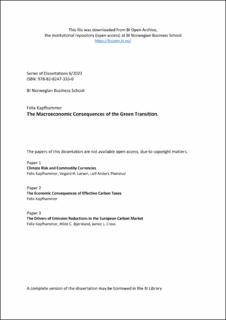| dc.description.abstract | Chapter 1: Climate Risk and Commodity Currencies – by Felix Kapfhammer, Vegard H. Larsen and Leif Anders Thorsrud Abstract: Climate change increases the likelihood of extreme climate- and weather-related events, but also the pressure to adjust to a lower-carbon economy. We propose a measure of climate change transition risk and document that when it unexpectedly increases, major commodity currencies experience a persistent depreciation in line with traditional general equilibrium arguments. Expanding the analysis to a richer set of countries we find a significant negative correlation between a country’s fossil fuel export dependency and exchange rate response to transition risk. None of these findings apply when existing climate risk proxies are used, suggesting that our proposed measure adds value and that not distinguishing between different climate risk components might misinterpret the economic consequences of climate change. Chapter 2: The Economic Consequences of Effective Carbon Taxes – by Felix Kapfhammer Abstract: This paper studies the economic consequences of carbon taxes at the macroeconomic and sectoral level. I propose a novel monthly measure of effective carbon tax rates, which, in contrast to the measures used by the existing literature, accounts for the time-varying emission coverage of taxes that are both explicitly and implicitly levied on greenhouse gas-emitting goods. Employing the new measure for four Nordic countries, I find that effective carbon taxes reduce emissions as expected but also decrease macroeconomic and sectoral activity - though there is some heterogeneity in the effects within and across the Nordic countries. Chapter 3: The Drivers of Emission Reductions in the European Carbon Market – by Hilde C. Bjørnland, Jamie Cross and Felix Kapfhammer Abstract: This paper studies the drivers of emission reductions in the carbon market of the European Union Emission Trading System (EU ETS) since its inception in 2005. We introduce a novel empirical framework that facilitates the joint identification of simultaneous demand and supply shocks underlying the European carbon market. Overall, emission supply conditions governed by the EU ETS reduced emissions by 46%, while demand associated with industrial economic activity increased emissions by 15%. The remaining 21% of emission reductions are attributed to other demand-side factors, which, we suggest, primarily reflect the transition to a low-carbon economy. | en_US |
